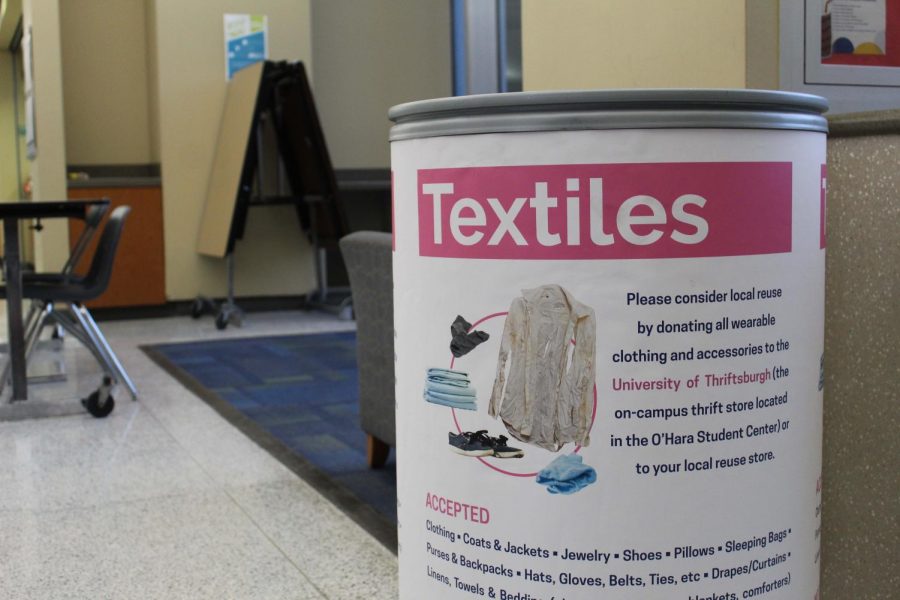How Pitt is choosing to reduce, reuse and re-wear
Carolyn Pallof | Staff Photographer
The Office of Sustainability partnered with PittServes, Logistics and The University of Thriftsburgh to implement a textile recycling program on Pitt’s campus. Nineteen collection bins are located around campus.
January 23, 2020
Blue bins, green bins and black bins — oh my. With so many ways to dispose of waste on campus, it can be hard to believe that Pitt didn’t start recycling until 1990. Now, 30 years later, there are even more bins popping up on campus.
The Office of Sustainability has partnered with PittServes and The University of Thriftsburgh to implement a textile recycling program on Pitt’s campus. Textiles are a category of materials including clothes and linens of all types and are characterized by their network of natural or artificial fibers. As it stands, textiles currently make up 6.3% of the United States waste stream. The recycling program aims to reduce the amount that end up in landfills.
As of this past Friday, 19 barrels marked with a wide, pink band around the top can be found everywhere from Cathy to the Pete. These barrels are being used to collect unusable textiles, including unwearable clothing and accessories.
There are specific guidelines that ensure only recyclable textiles are placed in the barrel. The list of items that cannot be placed in these barrels includes mattress toppers, hazardous waste and single-stream recyclables.
Aurora Sharrard, Pitt’s director of sustainability, said the barrels are not for clothing donations. Wearable clothing and other lightly used textiles should still be brought to local consignment stores such as the Thriftsburgh.
“Reuse is one of the highest and best uses for an item of any type,” Sharrard said.
The unusable textiles dropped in the recycling barrels are collected and taken to one of Pitt’s surplus property sites. From there, Simple Recycling, a textile recycling partner, picks up and transports the textiles to a regional facility. From there, all materials are sorted and graded based on quality and condition. The lower quality textiles are processed for raw materials and medium quality textiles are exported to partner organizations.
Sharrard said this process of both reusing and recycling keeps textiles in a circular economy.
“A circular economy is one that creates closed loops in which materials are used and reused, thus eliminating waste and responsibly [re]using resources,” Sharrard said.
Kevin Pealer, a senior environmental studies and communication major, as well as the executive board director at Thriftsburgh, said not many people understand the extensive impact textiles have when they are not kept in the circular economy.
“Textiles use a shocking amount of water and produce a very significant amount of pollution worldwide,” Pealer said.
Pealer added that the textile industry also has a negative impact on social equity, which can be attributed to factors like the exploitation of workers, fast fashion and overconsumption of clothing.
Tamara Racic, a senior neuroscience and psychology major, said reducing waste is a big part of being an active member of the Pitt community.
“We only have one world and we should take care of it,” Racic said.
Racic also said she wants Pitt to actually enforce the plans they put into place and make them more publicly known, including the textile recycling program.
Though Pitt will not be a zero-waste campus in the near future, Erika Ninos, the sustainability coordinator at PittServes, said the University’s recent initiatives have put that within reach.
“Pitt is making strides in this area on multiple fronts, from expanding building-wide composting to offering this new textile recycling service,” Ninos said. “Zero-waste is about being thoughtful in every sense, thinking about the inputs and outputs.”
With the implementation of the textile recycling program as part of campus sustainability initiatives, Pitt is planning to reduce 25% of landfill waste by 2030.
“While the University does not have a zero-waste goal in place,” Sharrard said, “many individuals and entities are adopting a zero-waste mindset. There’s a long way to go to reach that aspiration — and we need every member of the Pitt community to help get us there.”



